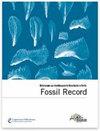立体胸中龙和圣保罗巴西龙(爬行纲,副爬行纲)的显微解剖和生长
IF 2.1
4区 地球科学
Q1 PALEONTOLOGY
引用次数: 4
摘要
摘要本文对10只巴西龙的立体胸骨和1只巴西龙的两根背肋骨进行了组织学和显微解剖研究。所有个体的体长都达到了50厘米(相当于已知最大体长的65%)或更大。由于髓腔的减少和髓区被髓内骨填充,所有样本骨都高度骨硬化。如果有钙化软骨的话,也只会在中轴的髓质区域局部出现少量钙化软骨,而在长骨的非中轴部分和中远肋轴处出现较多钙化软骨。初生骨组织由高度组织化的平行纤维组织和/或板层组织组成,在大多数样本中血管化程度相对较轻,甚至无血管。如果存在,血管管主要是纵向的;有些显示径向取向。出现简单的血管管和原发性骨。后者中的一些是次要改变的,即加宽。骨膜皮质的重塑仅被少量分散的侵蚀腔和继发性骨所记录。组织有规律地由生长阻滞线(lag)分层,通常表现为双重或多重休止线,表明对外源性和内源性因素有很强的依赖性。由于骨膜重塑的抑制,生长记录是完整的,没有内部周期丢失。立体胸骨个体的体型与生长标记数量的相关性较差,这可能是发育可塑性的结果。巴西龙显示出高度组织化的无血管板层组织和大量有规律地沉积在肋骨皮层的休息线。与立体胸骨相比,巴西龙肋骨的髓质区明显更大。然而,在这两个类群中明显存在强烈的骨硬化,表明它们高度适应水生环境。立体胸骨、巴西龙和中鼻龙的肋骨可以通过骨膜和内层的分布来明显区分。此外,与立体胸骨龙和中角龙相比,巴西龙的生长模式(即休止线的间距)有所不同。本文章由计算机程序翻译,如有差异,请以英文原文为准。
Microanatomy and growth of the mesosaurs Stereosternum tumidum and Brazilosaurus sanpauloensis (Reptilia, Parareptilia)
Abstract. Histology and microanatomy of vertebrae, ribs, haemal
arch, and humeri and femora of 10 individuals of Stereosternum and two dorsal ribs of
1 individual of Brazilosaurus were studied. All individuals had achieved a body length
of 50 cm (equal to 65 % of the maximum known body length) or larger. All sampled
bones are highly osteosclerotic due to the reduction of medullary cavities
and the filling of medullary regions by endosteal bone. Calcified cartilage
occurs – if at all – only locally in small clusters in the medullary
regions of midshaft and in higher amounts only in non-midshaft sections of
long bones and towards the medio-distal rib shaft, respectively. The primary
bone tissue consists of highly organized parallel-fibred tissue and/or
lamellar tissue, which is in most samples relatively lightly vascularized or
even avascular. If present, vascular canals are mainly longitudinally
oriented; some show a radial orientation. Simple vascular canals as well as
primary osteons occur. Some of the latter are secondarily altered, i.e. widened. Remodelling of the periosteal cortex is only documented by few
scattered erosion cavities and secondary osteons. The tissue is regularly
stratified by lines of arrested growth (LAGs), which usually appear as double or multiple rest lines,
indicating strong dependence on exogenous and endogenous factors. Because of
the inhibition of periosteal remodelling the growth record is complete and
no inner cycles are lost. Individuals of Stereosternum show a poor correlation of body
size and number of growth marks, which might be the result of developmental
plasticity. Brazilosaurus shows a highly organized, avascular lamellar tissue and a high
number of regularly deposited rest lines throughout the cortex of the ribs.
The medullary region in the ribs of Brazilosaurus is distinctly larger when compared to ribs
of Stereosternum. However, strong osteosclerosis is obvious in both taxa, pointing to a
high degree of aquatic adaption. Ribs of Stereosternum, Brazilosaurus, and Mesosaurus are clearly distinguishable
from each other by the distribution of the periosteal and endosteal
territory. Furthermore, Brazilosaurus differs in its growth pattern (i.e. spacing of rest
lines) when compared to Stereosternum and Mesosaurus.
求助全文
通过发布文献求助,成功后即可免费获取论文全文。
去求助
来源期刊

Fossil Record
PALEONTOLOGY-
CiteScore
3.60
自引率
7.10%
发文量
18
审稿时长
14 weeks
期刊介绍:
Fossil Record (FR) is the palaeontological journal of the Museum für Naturkunde Berlin. This journal was founded in 1998 under the name Mitteilungen aus dem Museum für Naturkunde Berlin, Geowissenschaftliche Reihe and appears with two issues each year. Fossil Record publishes original papers in all areas of palaeontology including the taxonomy and systematics of fossil organisms, biostratigraphy, palaeoecology, and evolution. All taxonomic groups are treated, including invertebrates, microfossils, plants, and vertebrates.
 求助内容:
求助内容: 应助结果提醒方式:
应助结果提醒方式:


